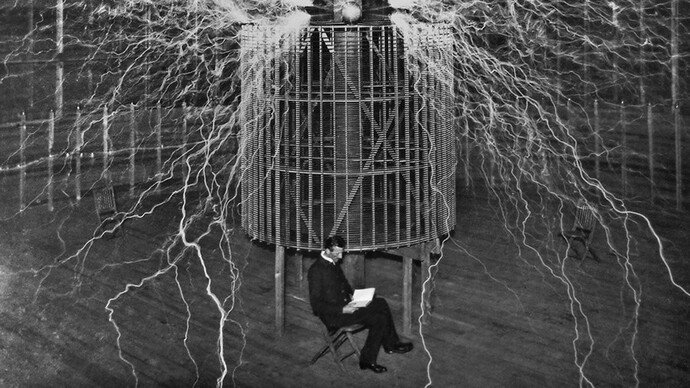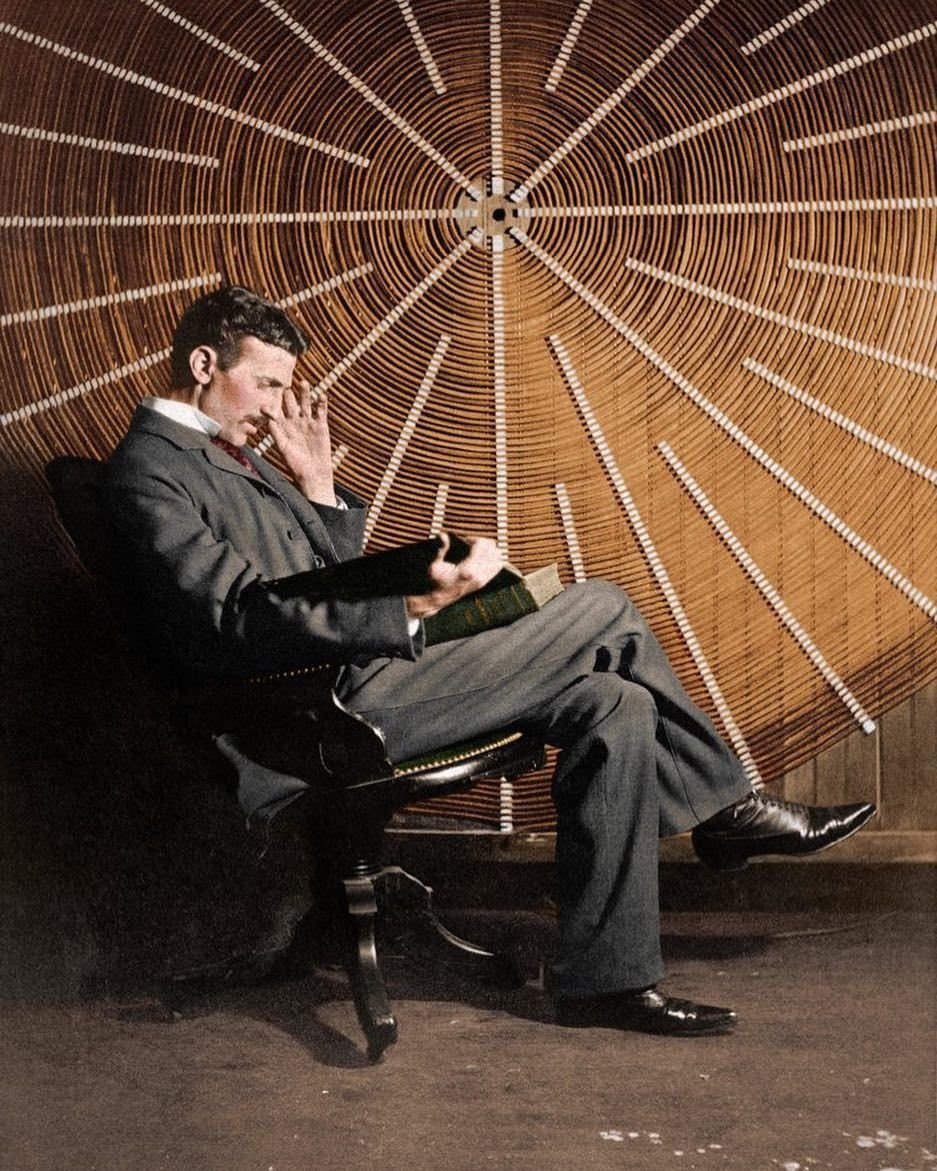Physical Address
304 North Cardinal St.
Dorchester Center, MA 02124
Physical Address
304 North Cardinal St.
Dorchester Center, MA 02124

Nikola Tesla keeps flickering into my mind lately, like a ghost who won’t settle. He’s more than the man who sparked the modern world—he’s a puzzle, a shadow slipping through the cracks of what we think we know.
Born in 1856 under a sky torn by lightning, he arrived with a hum most of us can’t catch. Sure, he was an inventor, a genius—but dig deeper, and he’s a mystic, a voice murmuring about forces we’ve barely touched.
Tesla didn’t just mess with electricity; he grazed the edges of the infinite, hinting at manifestation, at bending reality with thought. His life’s a cryptic trail, and if we follow it, it might just unravel something in us too.
It begins with a storm—July 10, 1856, Smiljan, Croatia. Thunder crashes, lightning slashes the night, and Tesla’s born into the chaos. His mother, Djuka, hears the midwife mutter he’s a storm-child. “No,” she fires back, “a child of light.” That’s the first thread of the mystery, isn’t it? From the start, he’s different—sharp, fragile, plagued by visions.
Flashes hit him: machines, inventions, ideas spinning whole in his mind. As a kid, he crafts tiny gadgets, dreams up impossible things, while his priest father pushes sermons and his mother stitches quiet knowing. But Tesla’s already hooked on something else—a signal from beyond the steeple.
He grows, dives into engineering, physics, math—gulps it down like air—but it’s not just study. He’s chasing a whisper. “My brain is only a receiver,” he’d say later, “in the Universe there is a core from which we obtain knowledge, strength, inspiration.” A receiver—for what? He doesn’t lay it out plain, but it’s there: he’s tapping into the unseen, threading it into something tangible.
And then there’s this: he thinks we can shape it. “The day science begins to study non-physical phenomena,” he wrote, “it will make more progress in one decade than in all the previous centuries.” That’s not a casual note—it’s a challenge, a glimpse behind the curtain.
Cut to the 1880s. Tesla’s in America, tangling with Edison over electricity—DC versus AC, tame versus untamed. Edison’s got the spotlight, but Tesla’s got the enigma. Alternating current isn’t just smarter; it’s a pulse he’s yanked from that cosmic drone.
He ditches Edison, scratches out a living, and in 1888, his AC motor patent splits the world wide. By 1896, Niagara Falls bends to his will, lighting cities, rewriting the game. It’s real, solid—but to Tesla, it’s more. “To create and to annihilate material substance,” he mused, “to cause at will the birth and death of matter… this is the ultimate goal.” That’s manifestation raw—energy turned solid, will turned real.
He keeps pushing—wireless power, free energy, a world where the air crackles with potential. Wardenclyffe Tower juts up in 1901, a weird, bony frame meant to fling electricity everywhere. He insists it’s doable, says the earth’s a wire, the sky a screen. “We are whirling through endless space,” he writes, “and everything is vibrating.”
He’s not just raising a tower—he’s clawing at the veil, trying to rip it open. The cash runs dry, the cynics sneer, and it collapses. But Tesla doesn’t blink. “The present is theirs,” he says of his rivals, “the future, for which I really worked, is mine.” That’s belief in the invisible, in a reality he’s already forged in his head.

Tesla’s no ordinary gearhead—he’s a seer with a toolbox. He’s fixated on threes, sixes, nines—circles buildings three times, counts steps in triplets. “If you only knew the magnificence of the 3, 6, and 9,” he said, “then you would have a key to the universe.” What’s he getting at? He doesn’t unpack it—just lets it drift there, thick with shadow.
Then there’s his mantra: “Think in terms of energy, frequency, and vibration.” It’s not just tech talk—it’s a chant, a code. He’s saying the world’s a riddle, and if you crack the rhythm, you can rewrite it.
He’s sure we’re not just here to tap power—we’re woven into it. “Man’s greatest discovery,” he hinted, “will be the realization that he can do what he thinks he can do.” That’s manifestation bare: thought as the flint, will as the flame.
He’d sit, eyes closed, crafting machines in his mind—perfect, alive—before touching a pencil. “I do not rush into actual work,” he said. “When I get an idea, I start at once building it up in my imagination.” That’s not tinkering—that’s summoning. And he’s nudging us: you’ve got the same spark, if you’d just hear it.
His quirks are breadcrumbs, too. He feeds pigeons in New York, falls hard for one—white, gray-tipped wings. “I loved her as a man loves a woman,” he confesses, “and she loved me.” Strange? Maybe. But it’s a peek at a soul that feels the pulse in everything, even a bird. Alone, no wife, no kids—he’s not hollow; he’s brimming with something else: stars, waves, a secret he hugs tight.
Tesla’s road isn’t all glow. He’s robbed—by Edison, by backers, by a world that grabs his light and forgets his name. He’s broke by the end, dodging bills, dying alone in 1943 in room 3327—those threes again. The FBI snatches his notes, whispers fly, and he fades into dusk.
But even there, he’s alive. “If your hate could be turned into electricity,” he wrote, “it would light up the whole world.” That’s not surrender—that’s a man who knows shadow’s just light waiting to shift.
He grappled, too. Letters show him clawing at silence, at a signal that sometimes dimmed. “I have not penetrated into the secrets of this core,” he admitted, “but I know that it exists.” That’s the mystery—he’s reaching, not landing. Yet he keeps at it, dreaming, trusting the unseen outshines the seen. That’s strength: to stride through the fog and still strike a match.

What’s Tesla murmuring to us through the haze? It’s veiled, fierce: you’re bigger than you know. He’s not giving us a rulebook—he’s tossing us a cipher. “The individual is ephemeral,” he said, “but the common mind is immortal.” He’s hinting we’re tied into something endless, and if we lean in, we can mold it. “My method is different,” he wrote. “I see the machine complete at once.” That’s manifestation: see it, hold it, birth it.
For me, it’s a call to the unknown. Tesla didn’t wait for the full picture—he felt the buzz and ran with it. He ditched comfort, fame, even reason sometimes, because he caught a thread truer than all that. What’s your thread? That faint pulse you’ve hushed, that vision you’ve stashed? He’s saying: don’t wait. Dream it whole. Vibrate with it. “If you only knew the magnificence of the 3, 6, and 9, then you would have a key to the universe”—that’s his tease, daring us to unlock what’s already ours.
It’s about release, too—not giving up, but giving over. He let go of the petty—riches, pats on the back—to seize the vast. What’s weighing you down? A doubt? A flinch? Drop it. Tesla’s life says the real juice flows when you stop clutching and start reaching.
Tesla’s dust now, but he’s here. His AC thrums in our walls, his echoes ripple in our tech—wireless whispers, electric veins. He died with empty pockets—no fortune, no heirs—but he left a blaze. He’s the kid born in thunder, the man who spoke to the void, the soul who saw the veil and tugged. “The universe is a symphony,” he might’ve said, “and we’re the notes.” He’s still humming, if we tune in.
So, try it—be a little Tesla today. Feel the static. Dream in hidden keys—3, 6, 9, whatever they unlock. Let go of the clutter and grab the hum. Ask: what’s my unseen? What can I conjure if I trust the signal? It’s not all clear—it’s a mystery, like him. But that’s the magic: you don’t need the whole flame to light it. What’s he whispering to you? Spill it—I’m all ears.